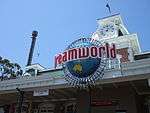Thunderbolt (Dreamworld)
| Thunderbolt | |
|---|---|
|
One of the Thunderbolt's trains passing through the second vertical loop. | |
| Dreamworld | |
| Park section | Country Fair |
| Coordinates | 27°51′54.5″S 153°18′59.5″E / 27.865139°S 153.316528°ECoordinates: 27°51′54.5″S 153°18′59.5″E / 27.865139°S 153.316528°E |
| Status | Closed |
| Opening date | April 1982 |
| Closing date | 8 August 2003 |
| Cost | A$3.3 million |
| Replaced by |
FlowRider WhiteWater World |
| General statistics | |
| Type | Steel |
| Manufacturer | Sanoyas Hishino Meisho |
| Model | Sitdown Looper |
| Lift/launch system | Chain Lift Hill |
| Height | 31 m (102 ft) |
| Length | 1,207 m (3,960 ft) |
| Speed | 87 km/h (54 mph) |
| Inversions | 2 |
| Capacity | 960 riders per hour |
| Acceleration | 0 to 87 km/h (0 to 54 mph) in 4 seconds |
| Height restriction | 120 cm (3 ft 11 in) |
| Trains | 2 trains with 6 cars. Riders are arranged 2 across in 2 rows for a total of 24 riders per train. |
| Loop Heights | 21 m (69 ft) |
|
Thunderbolt at RCDB Pictures of Thunderbolt at RCDB | |
The Thunderbolt was a steel roller coaster at the Dreamworld theme park on the Gold Coast, Australia. It was the park's original roller coaster opening in April 1982 before being closed on 8 August 2003. It was demolished the following year.
History
On 15 December 1981, Dreamworld officially opened to the public.[1] In April 1982, the park opened its first roller coaster, the Thunderbolt.[1] It was the first roller coaster in Australia to feature vertical loops.[2] Originally painted completely white, the Thunderbolt was repainted around 1990 to feature golden loops.[2] In 1995, a new train was purchased for half a million dollars in an attempt to make the ride more comfortable.[2]
In 2002, Dreamworld conducted a feasibility study into the possibility of redeveloping the attraction.[2] The park approached Arrow Dynamics, Kumbak and Vekoma, however, it was determined that the redevelopment was unfeasible due to the ride's condition.[2]
On 8 August 2003, the ride was closed.[3] It remained standing but not operating while attempts were made to sell the ride.[2] It was removed in March 2004 in such a way that it was clear it was not going to operate again.[4] Dreamworld retained a section of track and one train, both of which reside in the park's back-of-house areas.[2]
The land where Thunderbolt stood is partly occupied by Dreamworld's FlowRider installation. Future expansions of the WhiteWater World water park will utilise the rest of the Thunderbolt's former footprint.[5] The station building is now used for the internal entry to WhiteWater World and the FlowRider shop.[6]
Ride
Built by Japanese firm Sanoyas Hishino Meisho, the Thunderbolt measured 1,207 metres (3,960 ft) in length making it the longest roller coaster in Australia.[3][7] Despite the ride's closure, no Australian roller coaster has yet to beat that record.[2][7] It was capable of reaching speeds of up to 87 km/h (54 mph).[3] The ride, which stood 31 metres (102 ft) off the ground, featured two vertical loops standing at 21 metres (69 ft) each.[3]
References
- 1 2 "The Gold Coast finds a reply to Disneyland". The Age. 19 April 1982. Retrieved 17 February 2012.
- 1 2 3 4 5 6 7 8 "Thunderbolt (Dreamworld)". Parkz. Retrieved 17 February 2012.
- 1 2 3 4 Marden, Duane. "Thunderbolt (Dreamworld)". Roller Coaster DataBase. Retrieved 26 September 2010.
- ↑ Ellem, Ryan (4 March 2004). "Flame goes out on Thunderbolt". The Gold Coast Bulletin. p. 7.
- ↑ "Development Application Tracking - Application: MCU2700970". Gold Coast City Council. Retrieved 5 September 2010.
- ↑ "Dreamworld and WhiteWater World Map" (PDF). Dreamworld. Retrieved 26 September 2010.
- 1 2 Marden, Duane. "Roller Coaster Search Results". Roller Coaster DataBase. Retrieved 17 February 2012.
.jpg)
